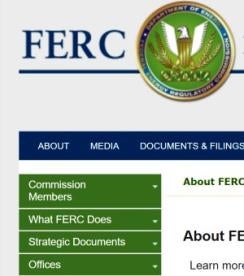After a 2-1 vote, on March 20, 2020, the Federal Energy Regulatory Commission (“FERC” or the “Commission”) issued a Notice of Proposed Rulemaking (“NOPR”), proposing to revise its existing electric transmission incentives policy and corresponding regulations to enhance opportunities for utilities to qualify for and receive transmission incentives, including additional return on equity (“ROE”) adders in transmission rates, for transmission projects that ensure reliability of the grid or reduce the cost of delivered power by relieving transmission congestion.[1] The Commission proposes to depart from a stricter “risks and challenges” test that many transmission owners and developers found difficult to satisfy.
The NOPR follows FERC’s March 2019 Notice of Inquiry (“NOI”) on its transmission incentives policies. The NOI resulted in 67 comments and 47 reply comments. We anticipate a similar high level of response to the NOPR. Comments are due 90 days from the date the NOPR is published in the Federal Register (it has not yet been published but comments will most likely be due in early July). This deadline is over the objection of the sole Democratic Commissioner Richard Glick, who cites industry disruption due to the novel coronavirus outbreak to support a 120-day comment period. Given the anticipated level of interest, it may be challenging for FERC to issue a final rulemaking order in this proceeding before January 1, 2021 even with an early July comment deadline unless these reforms are of the highest priority for the Commission. It is not certain what would occur to this initiative if there is a change in administration that resulted in a Democratic FERC Chair on January 1, 2021, although the dissent from Commissioner Glick and other anecdotal information indicates that a Democratic FERC will not support the proposed changes to FERC’s incentives policy.
The NOPR points to the change in generation resource mix, the increase in the number of types of generation resources relying on the transmission grid to facilitate their participation in the energy markets, shifts in load patterns, efforts to plan transmission on a regional basis (including but not limited to regional planning efforts resulting from FERC Order No. 1000), and new challenges to maintain reliability as precipitating factors for the NOPR. As noted above, the NOPR’s proposals would likely provide some upward adjustment to the ROE for many transmission owners/developers. Separate from transmission incentives, the Commission has been working for some time to develop an ROE policy that both encourages healthy transmission investment and that is able to withstand challenges on appeal. Inadequate authorized return on transmission investment could lead to critical transmission infrastructure not being built. Historically, the Commission’s ROE policy and the then prevailing capital markets’ conditions frequently produced base electric transmission ROEs in excess of 10% with expansive zones of reasonableness (zones of reasonableness that allowed utilities to generate healthy returns and benefit fully from any ROE adders). However, abnormal capital markets conditions that have persisted since 2009 and the Commission’s application of various ROE methodologies over recent years have resulted in lower transmission base ROEs for some transmission owners. In addition, for some transmission owners, the zone of reasonableness has narrowed and a narrow zone of reasonableness creates a challenge to those transmission owners seeking to benefit fully from ROE adders granted by the Commission pursuant to its transmission incentives policies as the Commission has capped the ROE at the upper end of the zone of reasonableness even if ROE adders resulted in a number higher than the upper end point of the zone.
In lieu of FERC’s Order No. 679 “risks and challenges” test to obtain transmission incentives, the NOPR proposes that FERC focus on whether a transmission project for which a transmission owner or transmission developer seeks incentives tends to improve economic efficiency or reinforce grid reliability. The NOPR also proposes “generous” ROE adders in certain other circumstances too.
Most of the NOPR’s proposed changes would increase ROE for investment in transmission projects that qualify for incentives. The Commission highlights the perceived failures of its Order No. 679, as well as of a relevant 2012 policy statement, for not achieving the statutory requirements of Federal Power Act (“FPA”) Section 219. Congress added FPA Section 219 in the Energy Policy Act of 2005. Section 219 directed the Commission to promulgate a rule focused on properly incentivizing the continued investment into transmission projects, which is expected, in turn, to “promote reliable and economically efficient transmission and generation of electricity.”[2] The NOPR concludes that Order No. 679 is not consistent with FPA Section 219 because Order No. 679 created overly burdensome requirements for investors to receive adequate incentives to commit resources to new transmission projects.
As mentioned above, the Commission proposes to replace the “risks and challenges” test that transmission developers currently must satisfy to qualify for ROE adders. Over the years, it has been difficult for transmission owners and transmission developers to satisfy the “risks and challenges” prong of the Order No. 679 test. Eliminating this requirement should remove a significant hurdle currently facing developer seeking FERC transmission incentives. In place of the “risks and challenges” test, the Commission proposes to institute a test focused on analyzing the “economic benefits” of a transmission project or the reliability benefits that a project may bring. The economic benefits test, for example, would provide a more streamlined process for securing additional transmission incentives for economic transmission projects by providing 50 and 100 additional basis points to the ROE for projects with a benefit-to-cost ratio in the top 75th and 90th percentiles of transmission projects, respectively. To assess the economic benefits of a transmission project for purposes of determining whether the project qualifies for ROE incentives, the Commission proposes to limit measurement of economic benefits to adjusted production costs or similar measures of congestion reduction or other quantifiable benefits. The NOPR notes that FERC considers these measures to be verifiable and not duplicative and referenced that centralized markets (ISOs/RTOs) and some non-RTO/ISO regions’ transmission planning processes rely on a production cost modeling approach to assess the economic benefits of proposed transmission projects.
Most of the proposals in the NOPR seek to promote certainty and simplification. For example, the NOPR’s penultimate proposal seeks to eliminate the current zone of reasonableness limit (or cap) on a public utility’s ROE and replace it with an express 250 basis point maximum ROE adder. Setting aside for now potential statutory and constitutional issues that may arise out of eliminating the zone of reasonableness test,[3] the new 250-basis-point cap would protect against the potential for a perceived “bait and switch” where FERC commits to a certain level of ROE adders that investors rely on only to subsequently see that benefit eroded after the investment has been made when FERC adjusts the top end of the zone of reasonableness downward so that the transmission owner is unable to obtain the full benefits of the ROE adder.[4] The 250 basis point cap on ROE adders limits the potential “bait and switch” investment risk associated with the Commission’s current policy of capping total ROE at the top end of the zone of reasonableness produced by the Commission-adopted ROE methodology. Thus, the Commission seeks to assure investors that they will continue to receive the full benefit of authorized-ROE adders no matter the result of any future application of the Commission’s ROE methodology in setting base ROE or setting a zone of reasonableness.
As alluded to at the outset, this NOPR comes at a time of great uncertainty in the U.S. and around the world with the spread of COVID-19. It is partially for this reason that Commissioner Glick dissents from issuing the NOPR – hoping to provide stakeholders up to 120 days, as opposed to the adopted 90-day period, to comment on the proposal.[5] Commissioner Glick also argues that the NOPR’s focus on immediate economic efficiency comes at the expense of long-term planning and the effectuation of “public policy goals.”[6] Commissioner Glick’s dissent refers to the Commission’s “failure to address transmission projects that serve public policy purposes,” namely ones that serve the grid’s transition towards low carbon and renewable fuels, as “the elephant in the room.”[7]
Commissioner Glick supports the NOPR’s proposed elimination of the special ROE incentive for companies that exclusively work on transmission projects (the “Transco Incentive”), but opposes other proposals that he fears will be ineffectual, or worse, such as the applicability of the Commission’s proposed cost-benefits test that will replace the “risks and challenges” test. In particular, Commissioner Glick fears that this change will be a “handout” and not an incentive because it will not influence developers’ decision-making and instead will reward projects that would have been built even without these particular ROE adders. In sum, in Commissioner Glick’s dissenting view, the proposed NOPR would increase costs to consumers without achieving significant public policy goals and potentially not incent any significant change in transmission companies’ behavior.
[1] Electric Transmission Incentives Policy Under Section 219 of the Federal Power Act, Notice of Proposed Rulemaking, 170 FERC ¶ 61,204 (2020) (“NOPR”).
[2] Id. at P 12.
[3] See Bluefield Waterworks & Improvement Co. v. Pub. Serv. Comm’n of W. Va., 262 U.S. 679, 692-93 (1923). See also FPC v. Nat. Gas Pipeline Co., 315 U.S. 575, 586 (1942) (holding that the statutory “just and reasonable” standard “coincides with that of the Constitution” in that the Commission is prohibited from setting a rate “which is so ‘unjust’ as to be confiscatory” under the Fifth Amendment).
[4] See Association of Businesses Advocating Tariff Equity v. Midcontinent Independent System Operator, Inc., Opinion No. 569, 169 FERC ¶ 61,129 (2019).
[5] FERC Commissioner Glick Statement on COVID-19 & FERC Orders, https://www.ferc.gov/CalendarFiles/20200319133030-Glick-031920.pdf
[6] NOPR, 170 FERC ¶ 61,204 (Glick, Comm’r, dissenting).
[7] Id.





 i
i


